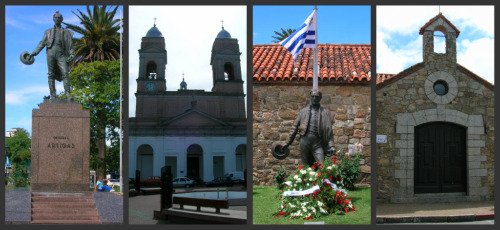Uruguay History
|
|
Uruguay history is an enchanting account of the life and times of the country and the proud people that live there.
The tales of this South American region contain an amazing amount of compelling details that will hold the interest of anyone whether they are a history buff or not.
A country of low, rolling plains on the east coast of South America, south of Brazil, Uruguay is roughly the size of the state of Oklahoma.
Uruguay history is full of stories that are steeped in Rich Culture as well as tales that contribute many unique bits of trivia and true, little known facts about Uruguay.
The indigenous people of Uruguay, the Charra, were the first to inhabit this country. These South American Indians roamed the grasslands of Uruguay, and were gatherers and fierce hunters, often collecting the skulls of their victims and using them as celebratory drinking cups.
The Charra people in Uruquay history were also artisans. Even in present-day Uruguay, local craftsmen and people of Uruguay use the same materials to wield their wares; soil, charcoal, sand and ash - as were available to the Charra as in the 16th century.

In 1516 the famed Spanish explorer, Juan Diaz de Solis sailed up the Rio de la Plata River, accompanied by two officers and seven men. Their expedition, however, was ill-fated. One account suggests that they had not gotten far before the Charra Indians attacked the explorers, reportedly killing and cannibalizing Diaz de Solis and some of his crew. Another version is that Diaz de Solis was mutinied and murdered by his crew.
In any event, the expedition was unsuccessful, and Diaz de Solis's brother-in-law, Francisco de Torres, assumed command, and returned with the ships to Spain.
The first successful settlement according to documented history was the town of Colonia del Sacramento, founded by the Portugese in 1680. Today, known for its historic quarter, a Heritage Site, Colonia del Sacramento is Uruguay's oldest town, still located by the Rio de la Plata River.
Battles for the territory followed, and after nearly 100 years of struggle, Portugal lost control of the country to Spain, in 1778. By this time, nearly all of the indigenous people of the land were gone. Uruguay was not content to be under Spanish rule, however, and in 1811, Jose Gervasio Artigas, who later became a national hero, led the country of Uruguay in a revolt against Spain, defeating them on May 18th of that same year. In 1814 Artigas formed the Liga Federal and would become known in Uruguay history as the Protector.
In 1821, Uruguay history details many Uruguay facts about the country's annexation by neighboring Brazil. This was when the country was given the name of the Provincia Cisplatina. This event was what gave rise to The Thirty-Three Orientals headed by Juan Antonio Lavalleja. According to Uruguay history this heralded the declaration of independence on August 25, 1825, and the action was supported by the United Provinces of the Rio de la Plata (later to be named Argentina).
A few years later, however, Provincia Cisplatina was conquered by the Portugese. In 1825, the region fought once again for their independence with the assistance of Argentina. A confrontation that would become known as the 500-day Argentina-Brazil War in Uruguay history soon followed.
Uruguay history shows that after three years, neither side had gained much ground, which led to the Treaty of Montevideo, in 1828. The treaty was then backed by the United Kingdom and according to Uruguay history documents these events then led to the declaration of Uruguay as an independent state.
Finally decreed as an independent state, Uruguay facts report that the country adopted its first constitution on July 18, 1830. History shows that the first President of Uruguay as being a man named Fructuoso Rivera, 1790-1854. He directed the succession of Manuel Oribe, against whom he revolted in 1836.
In 1839, Rivera declared war on Juan Manuel de Rosas, the ruler of Argentina and the United Provinces of La Plata. But, opposed by those within his party, Rivera was exiled from the city in 1847, fleeing to Brazil. He later returned, after the end of the siege and the ousting of Rosas, and was once again selected in 1853 as the head of the Uruguay government.
For the remainder of the 19th century, Uruguay history would continue to be rewritten to include a number of important transformations. The country experienced upheavals and controversies that included such events as elected (as well as appointed) presidents, and according to Uruguay facts the region also underwent numerous conflicts with surrounding states.
The country's political and economic climate continued to grow and change and Uruguay continuously experienced a large immigration inflow, mainly from new residents who were emigrating from Europe to cities of Uruguay.
In the 20th century, President Jose Batelley Ordnez (1903-1907; 1911-1915) began a new political movement that would have a big influence in Uruguay history. He would implement many reforms, including a welfare program. Some of his reforms were adopted and continued by his successors. Notable in Uruguay history is the country's involvement in world sports, especially the Football
World Cup, which it won in 1930 and again in 1950.
In the early 1960's, an urban guerrilla movement, the Tupamaros, formed and was responsible for much crime. They robbed banks and orchestrated political kidnappings and attacks on national security personnel. These actions embarrassed and eventually shook the Uruguay government and its people.
President Jorge Pacheco, in 1968, declared a state of emergency, and in 1972, his successor, President Juan Maria Bordaberry, enabled the Army to fight against the guerrillas.
After winning the fight against the Tupamaros, the military, under Pacheco's direction, took power in 1973, but it wasn't without its own disgrace, performing repeated acts of torture. Finally, Pacheco was removed from office in 1976. In 1981 General Gregorio Alvarez assumed the presidency, followed by Tabare Vazques in 2005.
Present-day Uruguay history continues to evolve and develop in many areas and there are new Uruguay facts being added to the country's legacy on a daily basis. It is this richly compelling history that helps create the sense of national pride in the South American country of Uruguay











Bookmark Us